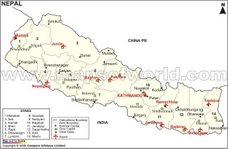
Rocks: Gold is present in tiny quantities in all igneous rocks. Some patches of rocks contain a high enough concentration of gold to make it worthwhile for companies to mine, crush, and chemically leach the metal from the ore. High -quality ore contains only about 30 grams of gold per ton of rock.
Reefs: On rare occasions gold is found in sheets or veins wedged between layers of quartz. This is known as reef gold.
Rivers: Over time, gold - bearing reefs that become exposed to sun, rain, and wind break down, releasing trapped gold, which then accumulates in creeks and rivers as tiny speaks, or flakes. In this form it is known as alluvial gold.
Earth's Surface: Odd -shaped clumps of gold that seem to form at random in the earth's surface are known as nuggets. These clumps can sometimes reach spectacular sizes. The largest gold nugget ever found in Australia was called The Welcome Stranger, and it weighed about 70 kilograms! It was discovered in 1869 in the Australia state of Victoria. Australia is the home of big nuggets, having yielded 23 of the 25 biggest nuggets ever discovered. Today gold nuggets, which can be as small as a match head, are more rare than gem -quality diamonds.
Collected from "Awake, September 22, 2005"
Reefs: On rare occasions gold is found in sheets or veins wedged between layers of quartz. This is known as reef gold.
Rivers: Over time, gold - bearing reefs that become exposed to sun, rain, and wind break down, releasing trapped gold, which then accumulates in creeks and rivers as tiny speaks, or flakes. In this form it is known as alluvial gold.
Earth's Surface: Odd -shaped clumps of gold that seem to form at random in the earth's surface are known as nuggets. These clumps can sometimes reach spectacular sizes. The largest gold nugget ever found in Australia was called The Welcome Stranger, and it weighed about 70 kilograms! It was discovered in 1869 in the Australia state of Victoria. Australia is the home of big nuggets, having yielded 23 of the 25 biggest nuggets ever discovered. Today gold nuggets, which can be as small as a match head, are more rare than gem -quality diamonds.
Collected from "Awake, September 22, 2005"











